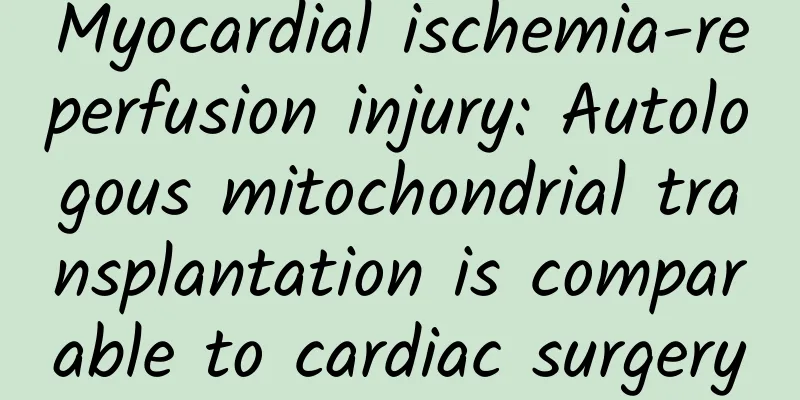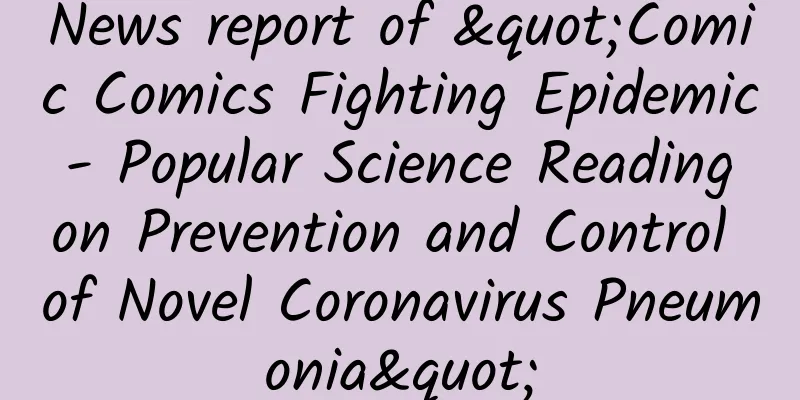Myocardial ischemia-reperfusion injury: Autologous mitochondrial transplantation is comparable to cardiac surgery

|
Myocardial ischemia-reperfusion injury is a well-known heart disease that can cause disability or even death in severe cases. This disease usually has two symptoms: cardiogenic shock and ischemia-reperfusion injury. Cardiogenic shock is a critical condition in which the organs throughout the body are not supplied with enough oxygen when the heart cannot pump blood effectively. In this case, if treatment measures are not taken in time, the organs throughout the body are likely to be paralyzed. Current treatment strategies include the use of drugs such as adrenaline and dopamine to maintain heart contraction, or considering the use of extracorporeal membrane oxygenation (ECMO) to help the heart pump blood. However, drug therapy has certain toxic effects and limited effects; ECMO not only requires professional equipment and monitoring, but also has the risk of complications. On the other hand, ischemia-reperfusion injury refers to the situation where more cell damage occurs when blood flows back to tissues that have been ischemic. Although the restoration of normal blood supply is important for tissue repair, reperfusion itself can also aggravate the degree of cell damage, making the original disease uncontrollable. Therefore, it is important to find a reliable and safe treatment method. A large amount of medical data shows that **mitochondria are the energy factories in cells, responsible for providing cells with the energy they need. **When myocardial cells are severely damaged, mitochondria may be affected, which in turn affects heart function. Therefore, scientists and doctors think: if healthy mitochondria are extracted from other parts of the patient's body and transplanted into damaged tissues, can they promote repair or recovery by enhancing the energy metabolism function in the tissue? In 2023, an article jointly published by the teams of Professor Zhang Jiayu and Professor Wang Changqian from the Ninth People's Hospital Affiliated to Shanghai Jiao Tong University School of Medicine pointed out that mitochondrial transplantation may protect the myocardium by increasing the number of healthy mitochondria, that is, restoring the normal metabolic function of mitochondria. As early as 2021, Emani, S. M.'s team from the Department of Cardiovascular Surgery at Boston Children's Hospital, Harvard Medical School, completed a clinical study on "The application of autologous mitochondrial transplantation to treat ischemia-reperfusion injury in pediatric cardiogenic shock patients". They referred to the condition of patients with cardiogenic shock after cardiac surgery admitted to the Fuwai Hospital of the Chinese Academy of Medical Sciences from May 2002 to December 2018, and admitted 24 pediatric patients, 10 of whom received mitochondrial transplantation and 14 received traditional medical treatment. The average age of the patients involved in the two was not particularly different. There were single ventricular physiological changes in 5 patients in the mitochondrial transplant group and 6 patients in the traditional medical treatment group, and there was no significant difference between the two groups. The probability of persistent separation of ECMO in patients receiving mitochondrial transplantation is twice that of patients treated with traditional medical treatment. The safety of mitochondrial transplantation was evaluated by indicators such as arrhythmia, white blood cell count and lactate content, blood parameters and renal function, and the results showed that they were all normal. In addition, **compared with traditional medical treatment, the overall incidence of cardiovascular events in patients receiving mitochondrial transplantation (such as hospital mortality during OHT, VAD and ECMO support) was lower. **During revascularization, there was no significant difference in the effects of the two. However, at the initial weaning, mitochondrial transplantation was significantly superior to traditional medical treatment. Therefore, choosing the innovative method of autologous mitochondrial transplantation to treat pediatric patients with myocardial ischemia-reperfusion injury not only does not cause the risk of cardiovascular complications, but also helps repair and protect heart tissue. It has to be said that **autologous mitochondrial transplantation has broken through the traditional treatment model and introduced a new treatment strategy for the field of cardiovascular surgery. **Of course, for a new method like autologous mitochondrial transplantation, only through continuous scientific research and clinical practice can it provide more choices and hope for health for patients with myocardial ischemia-reperfusion injury. Mitochondrial transplantation has shown promising preclinical results in limiting myocardial injury in the setting of IRI. Sources: 2. McCully, JD, Cowan, DB, Pacak, CA, Toumpoulis, IK, Dayalan, H., & Levitsky, S. (2009). Injection of isolated mitochondria during early reperfusion for cardioprotection. American journal of physiology. Heart and circulatory physiology, 296(1), H94–H105. https://doi.org/10.1152/ajpheart.00567.2008 3. Moskowitzova, K., Shin, B., Liu, K., Ramirez-Barbieri, G., Guariento, A., Blitzer, D., Thedsanamoorthy, JK, Yao, R., Snay, ER, Inkster, JAH, Orfany, A., Zurakowski, D., Cowan, DB, Packard, AB, Visner, GA, Del Nido, PJ, & McCully, JD (2019). Mitochondrial transplantation prolongs cold ischemia time in murine heart transplantation. The Journal of heart and lung transplantation : the official publication of the International Society for Heart Transplantation, 38(1), 92–99. https://doi.org/10.1016/j.healun.2018.09.025 4. Masuzawa, A., Black, KM, Pacak, CA, Ericsson, M., Barnett, RJ, Drumm, C., Seth, P., Bloch, DB, Levitsky, S., Cowan, DB, & McCully, JD (2013). Transplantation of autologously derived mitochondria protects the heart from ischemia-reperfusion injury. American journal of physiology. Heart and circulatory physiology, 304(7), H966–H982. https://doi.org/10.1152/ajpheart.00883.2012 5. Emani, SM, Piekarski, BL, Harrild, D., Del Nido, PJ, & McCully, JD (2017). Autologous mitochondrial transplantation for dysfunction after ischemia-reperfusion injury. The Journal of thoracic and cardiovascular surgery, 154(1), 286–289. https://doi.org/10.1016/j.jtcvs.2017.02.018 6. Kaza, AK, Wamala, I., Friehs, I., Kuebler, JD, Rathod, RH, Berra, I., Ericsson, M., Yao, R., Thedsanamoorthy, JK, Zurakowski, D., Levitsky, S., Del Nido, PJ, Cowan, DB, & McCully, JD (2017). Myocardial rescue with autologous mitochondrial transplantation in a porcine model of ischemia/reperfusion. The Journal of thoracic and cardiovascular surgery, 153(4), 934–943. https://doi.org/10.1016/j.jtcvs.2016.10.077 7. Shin, B., Cowan, DB, Emani, SM, Del Nido, PJ, & McCully, JD (2017). Mitochondrial Transplantation in Myocardial Ischemia and Reperfusion Injury. Advances in experimental medicine and biology, 982, 595–619. https://doi.org/10.1007/978-3-319-55330-6_31 8. Zhang, A., Liu, Y., Pan, J., Pontanari, F., Chia-Hao Chang, A., Wang, H., Gao, S., Wang, C., & Chang, AC (2023). Delivery of mitochondria confers cardioprotection through mitochondria replenishment and metabolic compliance. Molecular therapy : the journal of the American Society of Gene Therapy, 31(5), 1468–1479. https://doi.org/10.1016/jymitochondria transplanthe.2023.02.016 Written by Yoom Review: Shuxia Layout: Chu Han Submission cooperation: [email protected] |
>>: Calcium, Vitamin D and Physical and Mental Health
Recommend
Breast fat nodules
As our living standards continue to improve, the ...
What is postpartum disease?
In the medical sense, postpartum disease refers t...
Do children only have stuffy noses, runny noses, and sneezing when they have a cold? That may not be the case...
gossip In spring, if children repeatedly experien...
What causes pain and heaviness in women’s lower body?
It is a common condition for women to feel a sens...
World Glaucoma Week is here! Learn about glaucoma in 3 minutes: Early detection and early treatment are important
As the world's leading irreversible blinding ...
Is it normal to feel sore after a miscarriage?
It is best to take care of your body after an abo...
What are the symptoms after ovulation?
Getting married and having children is every woma...
The most severe symptoms of menopause
Many women experience some uncomfortable symptoms...
Does appetite decrease during ovulation?
I believe everyone knows the importance of ovulat...
Knowledge about urinary tract infection in women
We all know that our country is developing much f...
If a pregnant woman is troubled by cough, how should she take medicine?
Coughing is a common symptom of respiratory disea...
What should pregnant women do if morning sickness is particularly severe?
Morning sickness during pregnancy is a normal phe...
Best time to take a bath during early pregnancy
Many women think that they cannot take a bath aft...









